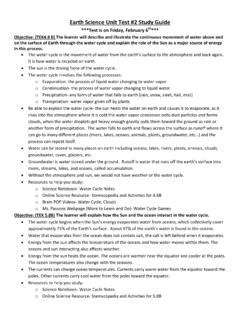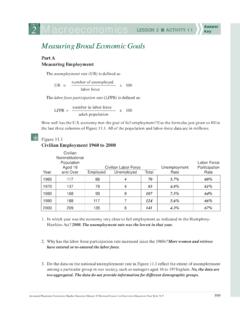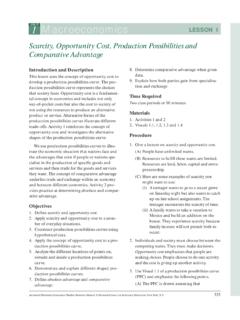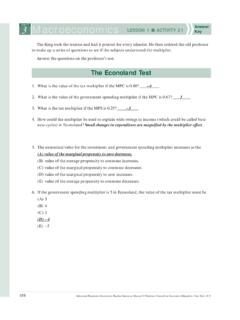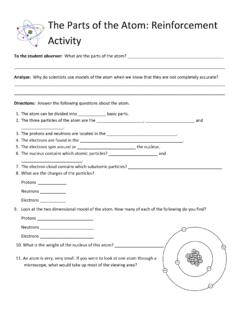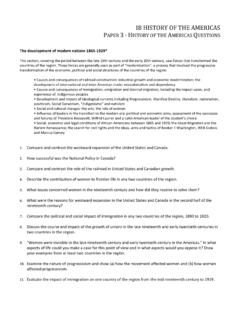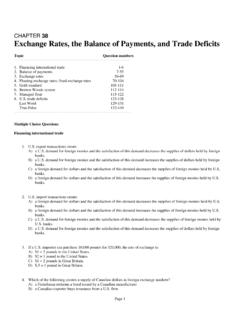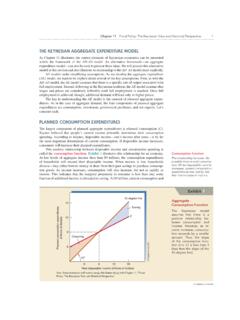Transcription of CHAPTER 7 Measuring Domestic Output, National Income, and ...
1 Page 1 CHAPTER 7 measuring domestic output , National income , and the Price Level Topic Question numbers _____ 1. GDP concept 1-15 2. C, I, G, and Xn components 16-43 3. Investment and the capital stock 44-57 4. GDP accounting: expenditure approach 58-75 5. GDP accounting: value added; income approach 76-85 6. Other social accounts 86-100 7. Real versus nominal GDP; price indexes 101-151 8. GDP and social welfare 152-156 Last Word 157-159 True-False 160-175 _____ Multiple Choice Questions GDP concepts 1. A nation's gross Domestic product (GDP): A) is the dollar value of the total output produced within the borders of the nation.
2 B) is the dollar value of the total output produced by its citizens, regardless of where they are living. C) can be found by summing C + In + S + Xn. D) is always some amount less than its C + Ig + G + Xn. 2. A nation's gross Domestic product (GDP): A) can be found by summing C + Ig + G + Xn. B) is the dollar value of the total output produced by its citizens, regardless of where they are living. C) can be found by summing C + S + G + Xn. D) is always some amount less than its NDP. 3. The GDP is the: A) monetary value of all final goods and services produced within a nation in a particular year.
3 B) National income minus all nonincome charges against output . C) monetary value of all economic resources used in producing a year's output . D) monetary value of all goods and services, final and intermediate, produced in a specific year. 4. Suppose Smith pays $100 to Jones. A) We can say with certainty that the GDP has increased by $100. B) We can say with certainty that the GDP has increased, but we cannot determine the amount. C) We can say with certainty that the nominal GDP has increased, but we can't say whether real GDP has increased or decreased. D) We need more information to determine whether GDP has changed.
4 5. Suppose the total market value of all final goods and services produced in a particular country in 2001 is $500 billion and the Page 2 total market value of final goods and services sold is $450 billion. We can conclude that: A) GDP in 2001 is $450 billion. B) NDP in 2001 is $450 billion. C) GDP in 2001 is $500 billion. D) inventories in 2001 fell by $50 billion. 6. National income accountants can avoid multiple counting by: A) including transfers in their calculations. B) counting both intermediate and final goods. C) only counting final goods. D) only counting intermediate goods. 7. gross Domestic product (GDP) measures and reports output : A) as an index number.
5 B) in percentage terms. C) in dollar amounts. D) in quantities of physical units (for example, pounds, gallons, and bushels). 8. GDP may be defined as: A) the monetary value of all goods and services (final, intermediate, and non-market) produced in a given year. B) total resource income less taxes, saving, and spending on exports. C) the economic value of all economic resources used in the production of a year's output . D) the market value of all final goods and services produced within a nation in a specific year. 9. By summing the dollar value of all market transactions in the economy we would: A) be determining the market value of all resources used in the production process.
6 B) obtain a sum substantially larger than the GDP. C) be determining value added for the economy. D) be Measuring GDP. 10. The term "final goods and services" refers to: A) goods and services that are unsold and therefore added to inventories. B) goods and services whose value has been adjusted for changes in the price level. C) goods and services purchased by ultimate users, as opposed to resale or further processing. D) the excess of exports over imports. 11. If intermediate goods and services were included in GDP: A) the GDP would then have to be deflated for changes in the price level. B) nominal GDP would exceed real GDP.
7 C) the GDP would be overstated. D) the GDP would be understated. 12. Which of the following is a final good or service? A) diesel fuel bought for a delivery truck B) fertilizer purchased by a farm supplier C) a haircut D) Chevrolet windows purchased by a General Motors assembly plant Page 3 13. Which of the following is an intermediate good? A) the purchase of gasoline for a ski trip to Colorado B) the purchase of a pizza by a college student. C) the purchase of baseball bats by a professional baseball team. D) the purchase of jogging shoes by a professor 14. Tom Atoe grows tomatoes for home consumption.
8 This activity is: A) excluded from GDP in order to avoid double counting. B) excluded from GDP because an intermediate good is involved. C) productive but is excluded from GDP because no market transaction occurs. D) included in GDP because it reflects production. 15. GDP includes: A) neither intermediate nor final goods. B) both intermediate and final goods. C) intermediate, but not final, goods. D) final, but not intermediate, goods. C, I, G, and Xn components 16. GDP can be calculated by summing: A) consumption, investment, government purchases, exports, and imports. B) investment, government purchases, consumption, and net exports.
9 C) consumption, investment, wages, and rents. D) consumption, investment, government purchases, and imports. 17. In National income accounting, consumption expenditures include purchases of: A) both new and used consumer goods. B) automobiles for personal use, but not houses. C) consumer durable and nondurable goods, but not services. D) consumer nondurable goods and services, but not consumer durable goods. 18. In National income accounting, consumption expenditures include: A) purchases of both new and used consumer goods. B) consumer durable goods and consumer nondurable goods, but not services. C) consumer durable goods, consumer nondurable goods, and services.
10 D) changes in business inventories. 19. Net exports are: A) that portion of consumption and investment goods sent to other countries. B) exports plus imports. C) exports less imports. D) imports less exports. 20. gross investment refers to: A) private investment minus public investment. B) net investment plus replacement investment. C) net investment after it has been "inflated" for changes in the price level. Page 4 D) net investment plus net exports. 21. Net exports are negative when: A) a nation's imports exceed its exports. B) the economy's stock of capital goods is declining. C) depreciation exceeds Domestic investment.
